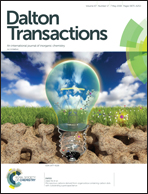Incorporation of Keplerate-type Mo–O based macroanions into Zn2Al-LDH results in the formation of all-inorganic composite films with remarkable third-order optical nonlinearity†
Abstract
Herein, new all-inorganic transparent composite films with the formula (Zn2Al-LDH/{Mo132-Ac})n have been fabricated by a layer-by-layer method using the exfoliated Zn2Al-LDH monolayer nanosheets and Keplerate-type macroanion {Mo132-Ac}. They were characterized by UV-vis absorption spectroscopy, SEM, AFM, and XPS techniques. The Z-scan measurements, which were conducted under laser irradiation at a wavelength of 532 nm, a pulse width of 6 ns, a repetition rate of 10 Hz, and the light intensity at a focus E0 of 10 μJ, revealed that all the films had notable saturated absorption and self-defocusing effect with a large third-order optical nonlinear susceptibility χ(3). With an increase in the number of layers (i.e., n) corresponding to the increase in the thickness of the films, the third-order nonlinear absorption β and refractive effects of the films were improved (i.e., the χ(3) value was up to 1.99 × 10−11 esu when n = 24); this implied that the NLO responses could be modified by fine-tuning the thickness of the composite films to meet the demands of different devices.



 Please wait while we load your content...
Please wait while we load your content...